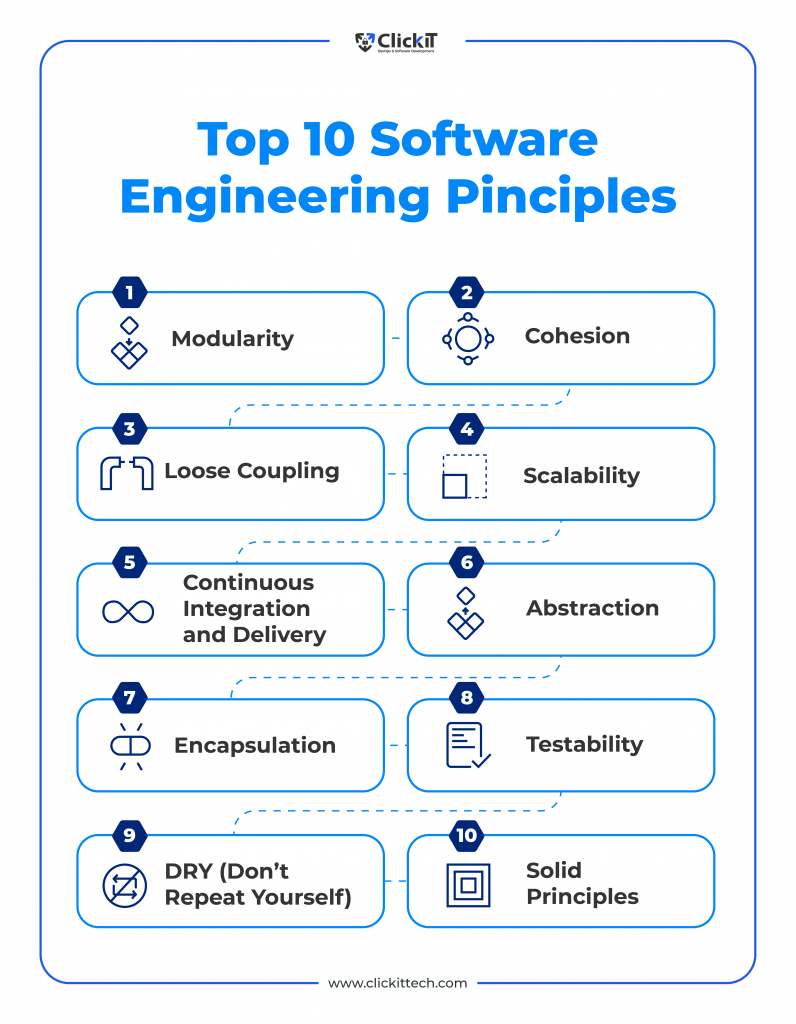Like sculptors, artists, potters, and other artisans, software engineers must follow specific guidelines to build the best product. Although each project will demand a unique approach, following software engineering principles will cut unforeseen delays, set the right team culture, and help you get the desired results faster. Learn the design principles of software engineering and more.
Many industry-recognized software engineers and authors have introduced the key design principles of software engineering. These best practices help you navigate the design, coding, and testing phases seamlessly to develop quality software suitable for the end user.
Here, we’ve compiled the top software development principles your team must adopt regardless of the project. But first, we’ll discuss the types of software engineering and why it matters in the modern business world.
- What is Software Engineering?
- What Do You Gain With Software Engineering Principles?
- Types of Software Engineering Principles
- Top 10 Software Engineering Principles
- Conclusion
- FAQs
What is Software Engineering?
Software engineering involves analyzing user requirements and then designing, developing, testing, and maintaining software applications to satisfy those requirements. To achieve this goal, software engineers must apply specific guidelines.
For example, it’s essential to conduct accurate user requirement analysis as this determines whether it meets the user’s needs. It’s also important to keep the design simple for smooth onboarding and use a modular approach to develop software functionalities. This improves the design process, allowing better workload handling, reusability, and easier debugging.
In addition, continuously validating the software and ensuring it’s scalable are also necessary principles.
Software engineering is important nowadays because engineers build programs and applications that make daily life easier and more convenient. Not only is it crucial for building innovative software solutions and application modernization, but software engineering is also a pivotal link between technology and business.
Due to the modern business’s rapidly-changing technological landscape, virtually every industry needs software engineers. From financial institutions, eCommerce, healthcare, biotechnology, agriculture, and more recently, blockchain, software engineering is essential to today’s technology-driven world.
What Do You Gain With Software Engineering Principles?
Every software development life cycle will face several issues when writing bug-free, readable, and maintainable code. For example, teams will contend with code errors and misprints, unclear and continuously-changing requirements, inadequate communication, undefined quality standards, etc.
Fortunately, the process is easier with a guide that helps you anticipate potential bottlenecks and how to solve them.
That’s what the design principles of software engineering provide.
Just as you would rely on a manual when using a product for the first time, software development principles are vital when making decisions during design, development, testing, and maintenance.
But there are many more advantages to following the design principles in software engineering:

- Improved Quality
Design principles in software engineering help teams build highly-reliable, efficient, and quality software applications that meet user requirements. By following specific principles, software engineers can create a product that is easy to understand, maintain, modify, and solves the user’s pain points.
- Reduced Development Time and Saves Development Costs
Sticking to a trusted guideline for building software will help teams avoid common software development delays. This can lead to faster development and time-to-market (TMM).
Quick product releases are not only a boon to customers but can also help a company manage its resources. By following engineering principles, teams will reduce the things that are not needed and focus on priorities.
Since big projects usually require businesses to make huge financial and time investments, completing them within or before the deadline will save costs.
- Improved Performance
Some design principles in software engineering standards for building reliable and effective software. Thus, following these principles will ensure the software is secure and performs optimally. This, in turn, will improve user experience.
- Reduces Complexities
Building software and applications, especially large-scale projects, is complex and challenging. Software development principles provide solutions to simplify problems and solve issues one after the other.
Read our blog Tips for Remote Work: Become a Remote Software Developer
Types of Software Engineering Principles
Design principles of software engineering apply to different stages of software development. Below we’ll discuss the different design principles of software engineering and how your team can practice them:

Agile Principles
Starting the list of design principles of software engineering principles: Agile principles give teams more control over their projects. Team members know exactly what to do in each sprint, and the increased emphasis on collaboration and communication reduces the possibility of mistakes or oversights.
These principles focus on iterative development, customer satisfaction, and continuously listening to market demands.
In the past, software engineering teams used a waterfall model, which outlined a rigid project roadmap from the onset. These plans were set in stone regardless of new knowledge or findings.
But change is constant, especially during software development. For example, there could be changes in the market, customer needs, and competition. From all design principles in software engineering, agile principles support responding to these constant changes rather than continuing despite them.
There are twelve types of agile principles to note:
1. Satisfy user needs
Software engineering teams can adopt this by shipping minimum viable products (MVPs) to test project hypotheses and validate ideas. There should also be frequent releases to generate a continuous feedback cycle between the product and the customer.
2. Welcome requirement changes even late in development.
Agile processes leverage change for the customer’s competitive advantage. To reflect new developments, tactical plans and the project strategy should be reviewed, adjusted, and shared with the team.
3. Deliver efficient software regularly.
This could be anywhere from a few weeks to a few months but focus on a shorter timescale. A good idea is to break development cycles into sprints to complete them in a set timeframe.
4. Collaborate
Business leaders and developers must collaborate daily throughout the project. A successful product needs insight from the business and technical aspects.
5. Build projects around motivated people
Provide an enabling environment and the right support they need. And trust them to complete their tasks.
6. Face-to-face communication
Is the most effective and efficient way of passing information within the team. You can achieve this through sprint planning meetings, daily standup meetings, pair programming, and frequent demos.
7. Progress
A working software application that customers love is the ultimate measure of progress. It doesn’t have to be done to be perfect. Focus on shipping core functionalities rather than full-developed feature sets.
8. Sustainable development
As such, all stakeholders, including developers, sponsors, and users, should maintain a constant pace indefinitely. To accomplish this, everyone must understand the tasks that should be completed during a sprint. Careful consideration of the work that can be committed should be done before every sprint to avoid over-commitment from software engineering teams.
9. Continuous focus
Should be on technical excellence and good design to improve agility. The team must be aware of technical debt and the implications of any new features added to the backlog. In addition, the team must allocate resources to refactoring regularly. Refactoring should not be an afterthought; it should be a continuous consideration.
10. Simplicity
It is essential as it maximizes the work done.
11. Self-organizing teams
To harness effective architectures, requirements, and designs. Rather than traditional development settings where the management makes key decisions, agile principles support autonomous teams where decisions are made as a group.
12. Become more effective
Teams should reflect on how they can become more effective and adjust their behavior accordingly. Just like there can be new findings for user requirements, the team can also learn new things from previous processes. Agile doesn’t follow a strictly-defined process; there’s room for continuous improvement of processes and teams.
Read our blog, Product Manager vs Product Owner

Design Principles
Design principles are one type of software engineering principle that provides guidelines to effectively deal with the complexity of the design process. Large-scale software development can be complex. Effectively managing complexity reduces the effort required for design and the possibility of committing errors during design.
Some software design principles your team should adopt include modularity, increased abstraction and cohesion, reduced coupling, and design for testability. Software engineering teams must also design for flexibility and portability, increase reusability, and anticipate obsolescence.
Coding Principles
Coding principles are concerned with helping software engineering teams write secure, reusable, and bug-free code. This reduces the risk of project failure, minimizes complexities, and enhances efficiency.
Considering how expensive it is to fix bugs, adopting coding principles ensures teams can write better code from scratch and make debugging a breeze.
Following this type of software engineering principle also help teams develop secure products and eliminates performance issues after deployment. The most secure software applications are those where security is built into the code from the onset. This provides greater depth to the application’s security and elevates the operational baseline.
In addition, coding principles reduce the frequency of code reviews. They guarantee code quality, readability and make them easier to analyze or work through.
Some good coding principles include DRY (Don’t Repeat Yourself), using a version control system, keeping it simple, open to extension/closed to modification (OCP – Open/Closed Principle), etc.
Testing Principles
Software testing involves implementing software to find defects or bugs.
Testing is a type of software engineering principle that has become extremely important as there has been an immense drive in the industry to raise standards. This is the reason for the additional development testing.
There are various testing principles.
End-to-end tests, which test how an application coordinates, and unit tests, which evaluate specific functionality, are the most rigorous.
To test a software application, it’s important to follow some principles that eliminate product defects and helps test engineers test the software with minimal effort and time.
Early testing is a principle that requires testing to start in the early stages of the SDLC – from the user requirement analysis.
Another principle is defect clustering which involves detecting the number of bugs correlated to a few modules. This is especially important when the modules are complicated, or the codebase is complex.
Some software engineering teams may also make testing context-dependent. Since multiple industries and products are on the market, this principle helps engineers test based on the application’s unique needs, features, and functionality. In this case, testing depends on the type of software engineering application being built.
Process Principles
Process principles are a set of fundamental rules, norms, or principles that guide what is beneficial and positive for the project process and how an assigned person or team should carry it out.
For example, a repeatable process is a set of actions or tasks that can be easily duplicated. This could include reusable program components or templates. There could also be a defined process that outlines a series of actions carried out to achieve a given result.
In addition, the managed principle involves a development process where the manager plans, organizes, and controls the activities and resources of an organization. Lastly,e optimizing processes means adjusting procedures to optimize a specific set of parameters without violating constraints.
For example, software engineering teams can aim to reduce development costs while increasing efficiency.
This type of software engineering principle and many others guide teams, helping them ship products faster and iterate more frequently. However, these principles can be overwhelming and contrasting.
For instance, agile principles may conflict with some process principles. That’s why it’s important to emphasize key principles of software engineering and the types that your team must adopt.
Read our blog, Top 10 Metrics Engineering.
What are the Best Software Engineering Principles?
Now that you know the types of Software Engineering Principles, let´s review the core principles teams must employ to make reasonable technical decisions based on user requirements, budget, project timelines, and stakeholder expectations.
These principles will help software engineering teams stay focused, collaborate seamlessly, and deploy products faster.
- Modularity
- Cohesion
- Loose Coupling
- Scalability
- CI/CD
- Abstraction
- Encapsulation
- Testability
- DRY
- SOLID

Software Engineering Principle: Modularity
If you’ve ever heard the expression “divide and conquer,” then modularity will make sense to you.
Modularization or modularity is the principle of breaking a software application into separate small modules. These modules are named differently and worked on independently before being integrated later for a complete and fully-functional software.
Large software is often challenging to understand and read because of the number of control paths, reference variables, and global variables. Modularity helps reduce the codebase’s overall complexity by breaking it down into smaller, manageable pieces.
Suppose we are building a software system that will process and analyze various data types, such as text, images, and videos. Rather than writing a single large program to handle all these different data types, we can divide it into smaller, modular components that can be built and tested independently.
For example, we can write a text processing module that handles all text-related operations like parsing, cleaning, and tokenizing data.
Similarly, we can write an image processing module that handles all image-related tasks like resizing, cropping, and filtering. We can also build a video processing module that handles all video-related operations like encoding, decoding, and compression.
As a result, testing, debugging, and upgrading individual modules is easier without affecting the rest of the system.
Benefits of Modularity to Software Engineering Teams
Besides providing more readable, well-designed, and testable software, here’s why your software engineering team should adopt modularization:
- Large programs can be written by multiple different people within a software engineering team.
- It adds more checkpoints for measuring progress.
- Encourages the team to have commonly used routines that can be placed in the library and reused by other programs.
- It streamlines the overlay procedure of transferring a large program into the main storage.
- It provides a framework for comprehensive testing and makes testing more accessible.
Cons of Modularization
The principle of modularity is not without its drawbacks. Here are some:
- Execution time may sometimes be longer. The same is true for compilation and loading time.
- The software engineering team may need more linkage. Plus, the team may experience longer run times, need to write more source lines, and more documentation is required.
- There might be an increased need for more storage.
- The team may face inter-module communication issues.
Read our blog Top 10 Software Development KPIs Your Team Needs
Software Engineering Principle: Cohesion
Cohesion is the degree to which the elements of a software component or module are related and work together to achieve a common functionality. In other words, software engineering teams will group similar functionalities.
If the elements of a module are closely related and work well together to achieve a specific purpose, the cohesion is high. This improves the module’s maintainability, and reusability, and makes it easier to understand.
On the other hand, low cohesion indicates that the elements of a module or component are not closely related and may serve different and unrelated purposes, making code maintenance and reuse more difficult.
Take a look at this practical example:
Suppose there’s a module that handles user authentication and authorization. This module’s functions validate user credentials, create and manage user accounts, and enforce access control policies.
If these functions are related and work well together towards the common goal of authentication and authorization, then the module has high cohesion.
However, if the functions in this module were unconnected and served different purposes, such as one for user account management and another for report generation, the module would have low cohesion.
This would make the module more challenging to maintain and modify, and it could introduce bugs and security vulnerabilities.
Cohesion organizes your code and makes it much easier to find things, eventually simplifying the system. Everything will become understandable. This way, you won’t have to search the dictionary package for machine learning-related functions.
Software Engineering Principle: Loose Coupling
Coupling refers to the degree of interdependence between one module or component of a software application and another module or component. It measures how changes to one module can affect the behavior of another.
High coupling indicates that the software application’s modules are highly dependent on one another. As a result, changing or modifying one might affect the others.
To loose coupling means reducing how the modules of the software depend on one another, making each one independent. This makes the system more modular, maintainable, and scalable.
By reducing coupling, software engineering teams make changing or modifying individual components easier without affecting the entire application. As a result, there may be fewer bugs, shorter development cycles, and higher code quality.
Consider this practical example:
Suppose your team is working on a complex codebase with several tightly coupled modules.
Since one module depends heavily on another, you’ll want to reduce coupling by using an approach called dependency inversion. Here, the team designs the modules to depend on abstractions instead of concrete implementations. Thus, the modules depend on an abstract class or interface rather than a certain implementation.
In the software development context, you may have Module X and Module Y.
X depends on Y to perform a specific task. To reduce the direct dependency, your team will create an abstract interface that both X and Y depend on. This interface defines the methods with which modules X and Y must interact.
Therefore, if you need to change Module Y, Module X will continue working fine without any issues.

Software Engineering Principle: Scalability
Scalability is a crucial software engineering principle to remember when developing software applications, especially enterprise software. It is the ability of a software system to handle increased data volume, workload, and usage without experiencing a decrease in reliability or performance.
In other words, scalability ensures that the software can handle future growth without requiring extensive re-architecture or re-implementation.
Prioritizing it from the beginning results in lower maintenance costs, a better user experience, and increased agility.
Web applications are a practical example of the importance of scalability in software development. When developing a web application, it is critical to consider how the app will handle increased traffic as more users start using it.
If the application is not designed for scalability, it may struggle to cope with the increased load, becoming slower over time or even crashing.
One trusted way of introducing the principle of scalability is by using a distributed architecture, such as microservices. This involves breaking the software application down into smaller and independently deployable services that can be scaled individually.
For example, if a specific service receives a high traffic volume, additional resources can be allocated without impacting the efficiency of other services.
Your software engineering team can also use cloud infrastructure. This means resources will be scaled up or down depending on demand.
For example, suppose a web app is hosted on a cloud platform like Amazon Web Services (AWS). In that case, additional computing resources can be provisioned as traffic increases or de-provisioned as traffic decreases.
This method enables the application to scale up and down automatically based on demand, eliminating manual intervention.
ClickIT’s engineers are masters in cloud architecture and developing scalable software. With over 50 certified AWS engineers, our skilled engineering teams provide high-quality software and cost-effective solutions regardless of the industry.
Software Engineering Principle: Continuous Integration and Delivery
Continuous Integration (CI) and Continuous Delivery (CD) are principles of software engineering where your team frequently delivers apps to users by automating the stages of development.
CI/CD helps your team deliver software changes more quickly and reliably. Following this principle reduces manual errors and ensures that changes are rigorously tested before they are released to production.
The significance of CI/CD lies in its ability to shorten the time between writing code and shipping it to users while also improving software quality and stability.
Your software engineering team can apply CI/CD principles to become more efficient by deploying products into the market faster than ever before. It also ensures an ongoing feedback cycle between the user and the product with new features and bug fixes.
CI/CD Benefits Video
Software Engineering Principle: Abstraction
Abstraction is one of the most fundamental software engineering principles. It involves hiding complex implementation details and ensuring users interact with a simplified interface.
Think of abstraction as a video game controller with only a few buttons, but there is a complex control mechanism in the background.
Abstraction is a critical because it allows developers to focus on essential software components while ignoring unnecessary details. Abstraction allows developers to create more flexible, modular, and reusable software components by separating high-level functionality from low-level implementation details.
One good example of applying this principle in your team’s software engineering is using application programming interfaces (APIs).
APIs provide a streamlined interface for accessing the functionality of a complex system, removing the need for the user to understand the fundamental implementation details.
Using object-oriented programming (OOP) concepts such as classes and inheritance is another example of abstraction in software engineering. Classes are used in object-oriented programming to abstract complex data structures and behavior into simple, reusable objects.
This helps developers and software engineers incorporate complex behavior and data structures to provide a simple user interface.
Ultimately, abstraction reduces code duplication and increases security.
Software Engineering Principle: Encapsulation
Encapsulation is another fundamental software engineering principle that your team must adopt. It is a data protection measure that bundles data and behavior into a single entity and restricts access to the entity from outside the object.
Encapsulation is critical in software engineering because it allows developers to control data flow and behavior within their applications. This, in turn, improves maintainability, security, and reusability.
By controlling access to an object’s data and behavior, the encapsulation principle ensures the object behaves consistently and predictably.
A good example of encapsulation is using classes in object-oriented programming (OOP). A class in OOP is a blueprint for creating objects that contain. Data is stored in variables known as attributes, and methods define the behavior.
For example, when developing a bank app, you can use the encapsulation principle to protect sensitive data like account balance and personal information from unauthorized access.
Let’s take a “BankAccount” class representing a user’s bank account. We can encapsulate the account balance field by making it private and providing public getter and setter methods to access and update the balance:
public class BankAccount {
private double balance;
public double getBalance() {
return balance;
}
public void deposit(double amount) {
balance += amount;
}
public void withdraw(double amount) {
balance -= amount;
}
}
In this Java example, the BankAccount class’s encapsulation of the balance field prevents direct access to or modification of the value from outside the class.
Instead, class clients must change the balance using the public deposit and withdrawal methods. This prevents data corruption and ensures that the balance is always updated accurately.
Software Engineering Principle: Testability
Software engineering teams must consider applications’ testability, especially when developing enterprise-level systems with large codebases. When building software, it’s crucial to make it testable to validate correctness, reliability, and performance. If your codebase is huge, ensure it is testable.
Here are ways your software engineering team can apply the testability principle:
- Build with testing in mind by creating modular code and writing easily-understandable code.
- Use automated testing frameworks. Automated testing allows you to create and run tests quickly, effectively, and more thoroughly. This reduces the time to run repetitive tests from days to hours. It will also save development costs.
- It’s important to test early and often. Contrary to the traditional approach of testing at the end, software engineering teams must conduct regular tests throughout the development life cycle. This involves testing individual components as they are built and testing the whole system as it is integrated. Testing early on can help software engineers catch and fix issues early before they become bigger problems.
- You should also consider using different testing techniques, such as white box, black box, regression, and exploratory testing. This ensures your code is thoroughly tested before being shipped to the user.
- This goes without saying, but it’s vital to monitor and analyze test results to identify weaknesses and improve code quality.
Adopting these testability principles will ensure your software engineering team builds a comprehensive product free from bugs and performs optimally.
Software Engineering Principle: DRY (Don’t Repeat Yourself)
DRY (don’t repeat yourself) refers to the practice of not writing duplicate code and instead using abstraction to consolidate routine tasks. Following this principle ensures every piece of knowledge in the software system has a single, unambiguous representation.
It’s important to avoid copying and pasting the same code repeatedly. If you do, you’ll be forced to make any changes in a particular place to every other place the code is repeated.
While this might seem easy for smaller projects, it can be hugely challenging to maintain large-scale systems with complex codebases. This requires more time, effort, and attention. And as a result, it might lead to slower development and time-to-market.
Repeating yourself also increases the likelihood of introducing errors and inconsistencies into your codebase.
Here are some tips to ensure you avoid duplicate code:
- Use functions and methods. Any code that appears twice or more should be moved into a separate function.
- Use object-oriented programming to create reusable code with classes and objects.
- Automate manual processes to keep the code lean.
- The software engineering team should consider using templates to create reusable generic code in different contexts.
- Refactor code. Although this might be time-consuming, it’s an excellent choice to validate the reliability of your codebase.
- Use code reviews to catch duplicate code.
By following these DRY principles, software engineering teams can write more extensible code with fewer bugs.
Software Engineering Principle: SOLID Principles
This is one of the most fundamental coding principles for software engineering teams. SOLID is an acronym that stands for the following principles:
- Single Responsibility Principle (SRP)
This principle states that every module or class in a software system should have one purpose. In other words, a class should have only one reason to change.
SRP doesn’t mean each class should only have one method, but rather that every method should be directly related to the class’s responsibility. If a class has multiple purposes, it should be changed into a new class.
- Open-Closed Principle (OCP)
The OCP principle states that software entities such as classes, modules, and functions should be open to extension but closed to modification. This implies that we ought to be able to expand the functionality of a system without changing the existing code.
As a result, it’s easier for your software engineering team to make changes to a part of the system without causing unintentional changes elsewhere.
- Liskov Substitution Principle (LSP)
According to this principle, a program using a base class should be able to use any of its derived classes without knowing it. Simply put, subclasses should be replaceable for their parent class without altering the correctness of the program. This makes the code more extensible and flexible.
- Interface Segregation Principle (ISP)
According to this principle, clients shouldn’t be made to depend on interfaces they don’t use. To put it another way, we should split interfaces into smaller, more specific ones so that users only have to rely on those that they actually use. Code becomes more modular and simpler to maintain as a result.
ISP is similar to the Single Responsibility Principle because the goal is to minimize unintended consequences and repetition by segmenting the software into numerous independent parts.
- Dependency Inversion Principle (DIP)
We already mentioned this principle earlier when discussing loose coupling. According to the dependency inversion principle, high-level modules shouldn’t depend on low-level modules, but both should depend on abstractions.
In other words, depends on abstractions, not concretions.
This means software engineering teams must program to interface, not to implement. As a result, the code becomes more adaptable, reusable, and testable.
This blog is also available on Medium.
Conclusion
Adopting and learning the design principles of software engineering make the development life cycle easier and faster, leading to the development of quality software that the user appreciates.
At ClickIT, our experienced software engineers apply the best principles to software development and DevOps. We provide best-in-class services by helping businesses build robust, secure, high-quality software applications that increase profitability and efficiency.
Want to learn more about how we can help you? Contact us today to learn more!

FAQs
Abstraction is the process of reducing complexity by hiding unnecessary underlying details and focusing on relevant information. On the other hand, encapsulation involves bundling data and behavior into a single unit, such as a class, and controlling access to that unit.
Abstraction can be achieved through encapsulation.
Testing is essential in software engineering because it validates your code’s correctness and helps ensure it is reliable and maintainable. Testing helps software development teams to catch and fix bugs early in the cycle. It also ensures that changes to a software system don’t have unintended consequences on other software elements.
Software engineering help businesses improve the cost of developing and maintaining software applications over their lifetime. Adopting software engineering principles enhance the quality of software, making it more useful and valuable to the user.
These principles also smoothen collaboration among software developers by improving communication, reducing errors, and ensuring every team member works towards the same goals. Lastly, software engineering principles promote innovation by encouraging developers to be creative while focusing on quality and reliable code.
When crafting and executing efficient C++ classes, it’s essential to incorporate software engineering principles to guarantee a well-organized, easily maintainable, and reusable codebase.
-Use Abstraction to concentrate on the core elements and shape classes that are more comprehensible and user-friendly
-Follow the SOLID principles (SRP, OCP, LSP, ISP, DIP).
-Use encapsulation and access specifiers.
-Utilize inheritance and polymorphism when appropriate








